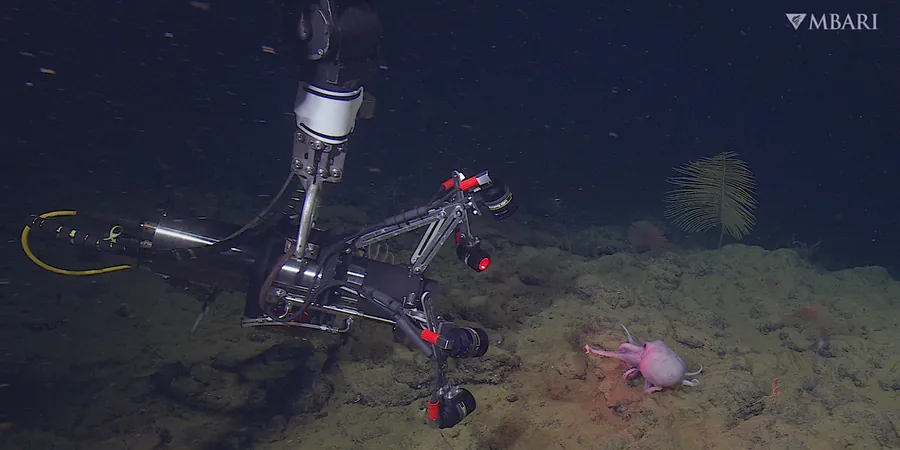
Revolutionizing Ocean Exploration: MBARI's Cutting-Edge Imaging System Unveils Secrets of Deep-Sea Life
2025-08-09
Author: Jia
When we embark on missions to investigate ocean worlds, it's critical for our robotic submersibles to be equipped with advanced observation capabilities. Right here on Earth, the Monterey Bay Aquarium Research Institute (MBARI) is paving the way with breakthrough technology to explore our planet’s uncharted ocean depths.
Introducing EyeRIS: The Future of Underwater Imaging
MBARI researchers have unveiled an innovative imaging system called EyeRIS (Remote Imaging System), designed for extensive underwater deployment. This system has recently been utilized to study the mesmerizing movements of deep-sea octopuses, with findings published in the prestigious journal Nature.
Unlocking the Mysteries of the Deep with 3D Imaging
EyeRIS is not just another camera; it captures intricate three-dimensional visual data, providing insights into the behaviors and movements of marine life in their natural habitats. Deployed aboard a remotely operated vehicle, the system observed the captivating pearl octopus (Muusoctopus robustus) at the renowned Octopus Garden off the coast of Central California.
Principal Engineer Kakani Katija highlights the significance of their work, stating, "In MBARI’s Bioinspiration Lab, we draw inspiration from nature to solve complex engineering challenges. Octopuses fascinate us with their unique biomechanics and ability to navigate complex terrains without bones."
Real-Time Tracking: A Closer Look at Octopus Movement
Thanks to EyeRIS, researchers were able to monitor several octopuses as they traversed their environment freely. Senior Research Specialist Crissy Huffard shared, "We obtained real-time 3D measurements of their arms while they crawled over the rugged seafloor, revealing critical details about their movement strategies."
A Technological Marvel: High-Resolution 3D Reconstruction
Equipped with a specialized, high-resolution camera array, EyeRIS captures simultaneous views, ensuring every pixel remains in focus. This technology allows for a remarkable three-dimensional reconstruction of an octopus's movements, enabling scientists to study intricate features with unparalleled precision.
Insights into Octopus Locomotion: Simplified Control Mechanisms
Through EyeRIS, researchers discovered that pearl octopuses utilize temporary muscular joints in their arms for efficient locomotion. Huffard pointed out that understanding these control mechanisms could pave the way for designing advanced, octopus-inspired robots and other bioinspired technologies.
The Future of Marine Research
As EyeRIS exemplifies, emerging technology is crucial to enhancing our understanding of marine life. This adaptable imaging system possesses the potential to study a wide array of marine creatures in both the seafloor and water column.
Katija expressed excitement about the future, stating, "There's so much left to uncover about ocean life. EyeRIS enables us to investigate the behavior of octopuses and other deep-sea organisms without intrusive methods, ultimately spurring innovation in bioinspired engineering."
Backed by Passionate Foundations
The development of EyeRIS was made feasible through the support of the David and Lucile Packard Foundation and the Gordon and Betty Moore Foundation.
About MBARI
Founded in 1987, the Monterey Bay Aquarium Research Institute (MBARI) is a non-profit organization dedicated to advancing marine science and engineering to comprehend the ever-changing nature of our oceans. Discover more at mbari.org.


 Brasil (PT)
Brasil (PT)
 Canada (EN)
Canada (EN)
 Chile (ES)
Chile (ES)
 Česko (CS)
Česko (CS)
 대한민국 (KO)
대한민국 (KO)
 España (ES)
España (ES)
 France (FR)
France (FR)
 Hong Kong (EN)
Hong Kong (EN)
 Italia (IT)
Italia (IT)
 日本 (JA)
日本 (JA)
 Magyarország (HU)
Magyarország (HU)
 Norge (NO)
Norge (NO)
 Polska (PL)
Polska (PL)
 Schweiz (DE)
Schweiz (DE)
 Singapore (EN)
Singapore (EN)
 Sverige (SV)
Sverige (SV)
 Suomi (FI)
Suomi (FI)
 Türkiye (TR)
Türkiye (TR)
 الإمارات العربية المتحدة (AR)
الإمارات العربية المتحدة (AR)